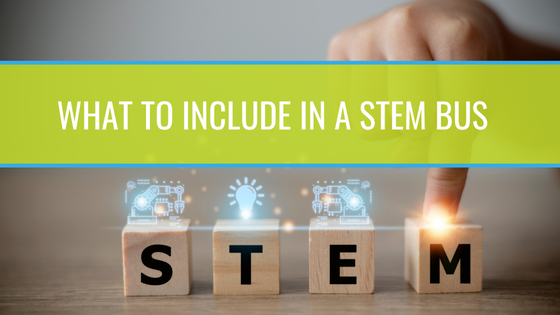School districts are getting creative with their STEM curriculum, and one of the newest trends is the STEM bus. What's a STEM bus? Take an old school bus, fix it up, outfit it with AV technology and you've got a mobile STEM station. With a STEM bus, districts can deliver curriculum to several schools on a rotating basis. For schools that don't have the space or budget for a traditional makerspace, STEM buses are the next best thing.
If your district is also considering one, you'll need some AV support to pull it off. Here, we've included the audio and visual technologies that can help your school do that. With these solutions, you can turn any old bus into a STEM-lab-on-wheels.
You Could Use the STEM Bus Like a Mobile Makerspace
Makerspaces are a proven tool for educators, giving students the space and resources they need to explore the world of STEM. And if it works so well, why not take the same approach with your STEM bus?
If your STEM bus is going to double as a makerspace, then you'll need makerspace furniture and technologies to bring it to life. For example, 3D printers can turn your bus into a mobile engineering lab, allowing students to design and produce their own creations. The 3D printers used in
education are small enough that they can be mounted to a cart or desk, so you don't need a lot of room to operate them.
Your STEM bus can offer low-tech projects, too. With makerspace storage, STEM buses can keep an array of craft materials - rubber bands, string, craft sticks, pipe cleaners, paper, you name it - and keep them organized during transit.
Digital Displays Offer a Compact, Engaging Way to Deliver Curriculum
Most STEM buses are zoned so that students move from one station to another during the class. There may be several projects going on inside a single bus, so keeping students focused on what they're doing is critical.
Digital displays are a simple solution in this scenario. Digital displays can be used to deliver lesson content and instructions, and their ability to engage will keep students at their stations. Better yet, digital displays are slim and compact, so you can fit several in a single STEM bus without crowding things.
Some districts also opt for interactive displays like the Clevertouch. An interactive display makes perfect sense for STEM teaching because it can be used to brainstorm, sketch and plan projects. This can also be used to introduce collaboration skills to students and encourage them to work as a team.
Enhanced Audio Solutions Allow Instructors to Maintain Control of the Experience
Don't forget about the audio side, which can be used to maintain order inside an active STEM bus. Audio enhancement solutions are simple, consisting of a microphone (worn or mounted), speakers and an amplifier. They're also simple to use and teachers can get comfortable with them in moments.
Audio enhancement can be used to drive learning experiences or used to direct students during the class. Some districts use their STEM bus to create a single, cohesive lesson that's reinforced through learning stations onboard the bus. With audio enhancement, students can be immersed in rich sound that excites, so children are engaged and ready to go.
As a support solution, audio enhancement makes it easy for educators to communicate with everyone onboard at once. This can be used to rotate kids from one station to the next, remind students of the time, and keep students engaged.
VR Solutions are a Good Fit for STEM Buses and Their Tight Spaces
For STEM buses, the primary limitation is space. You've only got so much to work with, which takes some ideas off the table. However, there are some AV solutions perfectly designed for smaller environments, and virtual reality is one that tops the list.
VR solutions, like
ClassVR, take up almost no space and work with only a headset and connected device. During a ClassVR session, students do not need to walk around to control the device, and teachers retain full control over the experience.
The beauty of virtual reality is that it can be combined with any other STEM curriculum. For example, if your students are learning about astronomy, VR can put students on Mars and let them walk around. If your students are learning about science, VR programs can reinforce everything students are learning in their classrooms. If students are learning about robots, VR can introduce engineering concepts in a lifelike 3D environment.
With its excellent engagement, versatility and small size, VR is a match made for STEM buses.
STEM Buses are Complicated Projects, so Work with a Certified AV Integrator
AV integration is challenging even in ideal conditions. Installing AV equipment in a school bus, though? That's a different kind of challenge.
If your district is just beginning the process, consider working with a certified AV integrator to execute and oversee the project. An integrator can map out ideas for your STEM bus before you've even got a vehicle picked out. And once a bus is picked out, an integrator can design the AV solutions for the bus, source all technologies, install them, ensure they are operating as intended, and maintain them so that they provide a reliable STEM experience for students.
STEM curriculum is an area of focus for many districts, but budgeting and space-related hurdles may be too high for some districts to clear. If they are, a STEM bus is a viable alternative. With the right AV solutions in place, they can provide STEM learning wherever it's needed.



